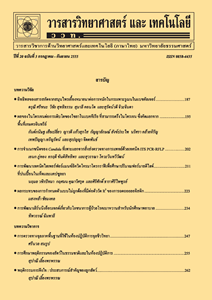การพัฒนาการผลิตก๊าซมีเทนจากน้ำเสียอุตสาหกรรมแป้งมันสำปะหลังโดยการเติมโลหะไอออน
Main Article Content
Abstract
Utilization of biogas product from starch industry wastewater can be problematic due to relatively low productivity with methane content of less than 55 %. One of the reasons affecting methane production is nutrient deficiencies in microorganisms. This research studied the optimization of methane production from starch industry wastewater by addition of various ion metals. The potential for methane production was investigated by adding 7 ion metals including Fe, Ni, Zn, Co, Mo, Cu and Mn. The experiment included 3 groups, i.e. group 1, 2 and 3 that contained 3, 4 and all 7 types of ion metals, respectively, at different concentrations (low, medium and high) based on suggested literature. The process was conducted in batch fermentation, working volume of 400 mL, with temperature controlled at 35±2 ºC. The result shows that addition of 4 ion metals: Co, Mo, Cu and Mn at low concentration in starch industry wastewater is the most suitable condition for increasing methane in biogas. The methane production potential increased from 277±2 to 309±3 ml/gVSadded or increased 11.55% with faster production rate compared to the control by 12 days of HRT. It is therefore one alternative to enrich methane content in biogas from starch industry wastewater.
Article Details
References
[2] Alternative Energy Development Plan: AEDP2015, September 2015, Department of Alternative Energy Development and Efficiency, Ministry of Energy, 15 p. (in Thai)
[3] Production potential and used of biogas as energy, Department of Alternative Energy Development and Efficiency, Ministry of Energy, Available Source: http://biogas.dede.go.th/biogas/web_biogas, December 18,2017 (in Thai)
[4] Worapot, K., 2012, Biogas Production Using Sludge Cake from Cassava Starch Production Process, Master Thesis, Graduate School, Khon Kaen University, Khon Kaen. (in Thai)
[5] Tapioca Development Institute, National Science and Technology Development Agency, 2016, Available Source: www.nstda.or.th/th/th/industrial-research/907-cassava, December 18,2017 (in Thai)
[6] Thailand Tapioca Starch, Available Source: http://www.thailandtapiocastarch.net/index.php, December 18,2017 (in Thai)
[7] Savent, P., 2002, Utilization of Nutrient Starch Industrial Waste for Fluid Compost Production, Research Report, Department of Natural Resources and Environment, Faculty of Agriculture Natural Resources and Environment, Naresuan University (in Thai)
[8] Zandvoot, M.H., van Hullebusch, E.D., Fermoso, F.G. and Lens, P.N.L., 2006, Trace metals in anerobic granular sludge reactors: Bioavailability and dosing strategies, Eng. Life Sci. 6: 293-301.
[9] Osuna, M.B., Lza, J., Zandvoort, M. and Lens, P.N.L., 2003, Essential metal depletion in an anaerobic reactor, Water Sci. Technol. 48: 1-8.
[10] Dermirel, B. and Scherer, P., 2011, Trace element requirements of agricultural biogas digesters during biological conversion of renewable biomass to methane, Biomass Bioenergy 35: 992-998.
[11] Gustavsson, J., 2012, Cobalt and nickel bioavailability for biogas formation, Doctoral Dissertation, Linkoping University Electronic Press.
[12] VDI-4630, 2006, Fermentation of Organic Materials: Characterization of the Substrate, Sampling, Collection of Material Data, Fermentation Tests. Verlag des Vereins Deutscher Ingenieure, Düsseldorf, 92 p.
[13] Speece, R.E., 1996, Anaerobic Biotechnology for Industrial Wastewater, Archae Press, Nashville, TN.
[14] Oechsner, H.W., Lemmer, A., Hamhold, D., Mathies, E., Mayrhuber, E. and Preibler, D. Method for producing biogas in controlled concentrations of trace elements, Patent US20100304457 A1, 2 December 2008.
[15] Mackenzie, L.D. and Cornwell, D.A., 2008, Introduction to Environmental Engineering, McGraw-Hill, Singapore.
[16] BMP, 2011, Energy Research and Development Institute-Nakornping, Chiang Mai University, Chiang Mai. (in Thai)
[17] Sawyer, C., McCarty, P. and Parkin, G., 2003, Chemistry for Environmental Engineering and Science, 5th Ed., McGrawhill, New York.
[18] Alkalinity, Department of Alternative Energy Development and Efficiency, 2008, Available Source: http://www2.dede.go.th/km_ber/Attach/Biogas-present.pdf, December 18,2017 (in Thai)


